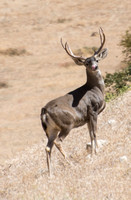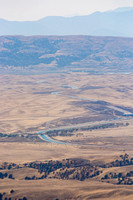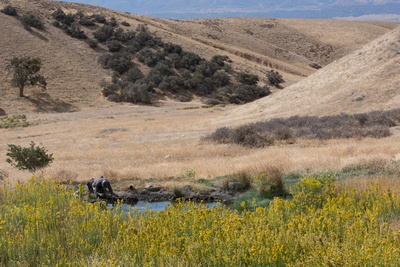Tejon Ranch Invertebrate Bio"Bliss"


A BioBlitz is when a group of people, including experts, get together to identify as many different biological organisms as they can in a given area in a short period of time. These BioBlitzes serve several purposes from engaging the public in conservation to gathering scientific information. I have participated in a number of citizen science BioBlitzes and this one, camping and searching for invertebrates with the Tejon Ranch Conservancy and the Lorquin Entomological Society, is one of my favorites. I feel truly privileged for the opportunity to join this group and lend my skills as a nature photographer, my somewhat limited but growing knowledge of entomology, and my curiosity of and my passion for discovery of Southern California fauna.
Tejon Ranch is an amazing place. It is the largest contiguous private landholding in California at 270,000 acres. The owner of the land reached an agreement with several environmental groups to leave 90% of the land undeveloped in exchange for unchallenged development of the other 10%. The Tejon Ranch Conservancy was created to document, enhance, maintain, and restore the ranch's ecosystems.
 Mule Deer - Odocoileus hemionus
Mule Deer - Odocoileus hemionus 
 Blainville's Horned Lizard - Phrynosoma blainvilliiBlainville's Horned Lizard - Phrynosoma blainvillii Tejon Ranch, 09/12/2016
Blainville's Horned Lizard - Phrynosoma blainvilliiBlainville's Horned Lizard - Phrynosoma blainvillii Tejon Ranch, 09/12/2016 Tejon Ranch encompasses areas of Antelope Valley, Tehachapi Mountains, the base of the southern Sierra-Nevada Mountains, and the western edge of the Mojave. This makes for rich biodiversity. Because this is a private land holding, there has been limited access to the land for scientists and the public. While a fair amount is known about the mammals, birds, and reptiles that call it home, there is still much to be discovered, particularly when it comes to invertebrates. That’s where we come in.
Tejon Ranch encompasses areas of Antelope Valley, Tehachapi Mountains, the base of the southern Sierra-Nevada Mountains, and the western edge of the Mojave. This makes for rich biodiversity. Because this is a private land holding, there has been limited access to the land for scientists and the public. While a fair amount is known about the mammals, birds, and reptiles that call it home, there is still much to be discovered, particularly when it comes to invertebrates. That’s where we come in.
Our group of seven drove to the top of one of the mountain ridges. I was a bit white-knuckled as our van made its way up a steep gravelly narrow road with a sharp drop-off on one side. But, from there on, it was a completely blissful adventure. The weather was perfect, not too hot, and the wind was unusually calm.
 California AqueductCalifornia Aqueduct Tejon Ranch, 09/12/2016
California AqueductCalifornia Aqueduct Tejon Ranch, 09/12/2016 The views from the top were magnificent. The rolling golden California hills, the valley and distant mountains, and a view of the California Aqueduct reinforce my love of this state. We walked down the mountain passing pinyon pines,
The views from the top were magnificent. The rolling golden California hills, the valley and distant mountains, and a view of the California Aqueduct reinforce my love of this state. We walked down the mountain passing pinyon pines,
 Tejon Ranch, 09/12/2016
Tejon Ranch, 09/12/2016 manzanita, oaks, and chaparral for about four miles at a very leisurely pace. We made frequent stops to photograph insects along the way. When someone found something particularly good, we all gathered round to share. It is wonderful to have passion for something, but I am extremely fortunate to have others who share these often underappreciated interests. My fingers were blistered from gripping my camera and trying to capture all I saw. And I was not even close to capturing as much as some of the others!
manzanita, oaks, and chaparral for about four miles at a very leisurely pace. We made frequent stops to photograph insects along the way. When someone found something particularly good, we all gathered round to share. It is wonderful to have passion for something, but I am extremely fortunate to have others who share these often underappreciated interests. My fingers were blistered from gripping my camera and trying to capture all I saw. And I was not even close to capturing as much as some of the others!
After about six hours, we went down to our camp at Pescadero Creek. We pitched our tents, ate some dinner, and told a few jokes. I turned in a bit early while the others went off to look for critters in the dark. The winds were cooperative during the night and I slept cozily in my sleeping bag. The next morning, the temperature dropped and we bundled up and regrouped over breakfast and coffee. We walked a short way from camp to a very small pond.
A small water source in an otherwise quite dry area attracts many critters, and it was teaming with life. We saw insects associated with water, frogs, and I had the good fortune to be startled by a California king snake,
 California kingsnake - Lampropeltis getula californiae
California kingsnake - Lampropeltis getula californiae
which I announced to the rest of the group with a sharp squeal of surprise -- and delight.
After a few hours recording our findings, we drove to another area of the ranch, this one populated with Joshua Trees. I’m sure this area is richer in the spring, but we managed to find a few gems in the dry autumn desert.
We have been logging our findings in iNaturalist which will be used by the Conservancy to add to their compilation of species on the ranch. We covered a very small portion of the ranch and for such a short time, but I am sure we added some significant findings. I look forward to many more opportunities to visit, explore, and discover at Tejon Ranch.
View more of my photos here. http://kimssight.zenfolio.com/tejon_sep_2016
Thank you to Cedric, Chris, James, and the iNat community for help with identifications. As always, I welcome corrections.
| “I am dying by inches, from not having anybody to talk to about insects...” ― Charles Darwin, Letters. A Selection, 1825–1859 |
Comments
Nice blog entry. That Tejon Trip was epic!
